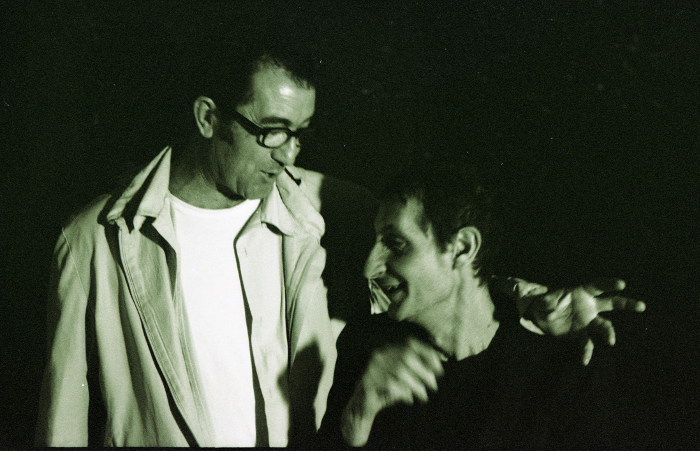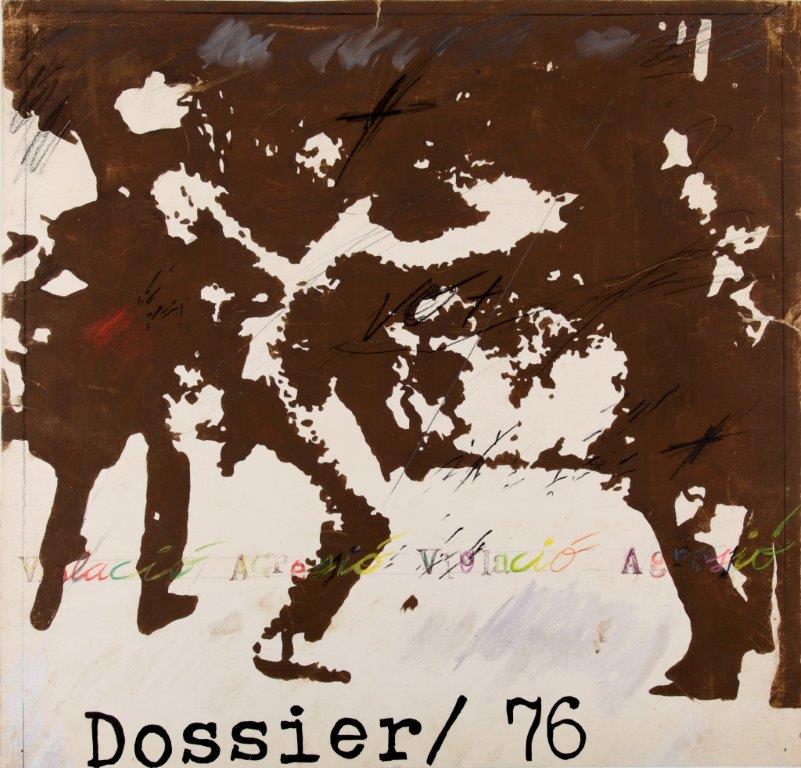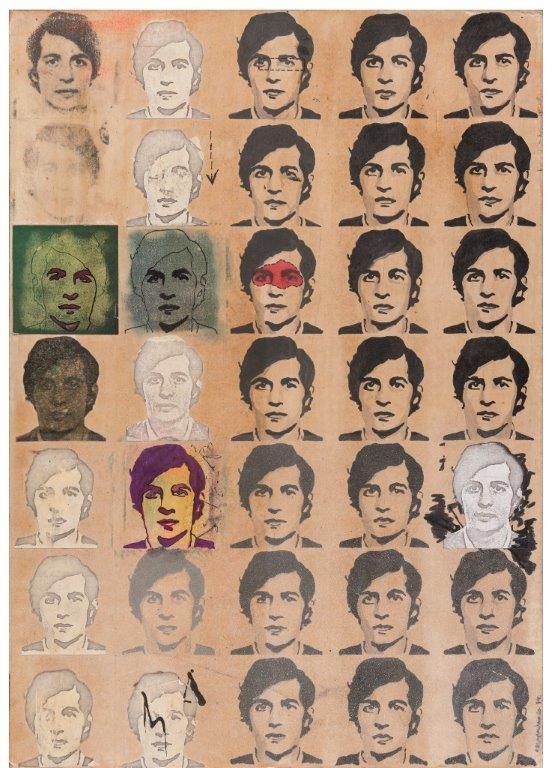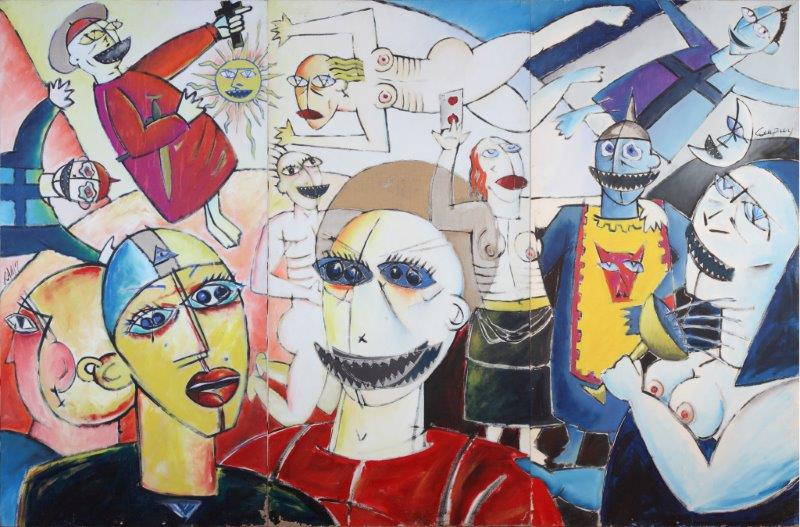Centre Cultural La Nau, Sala Estudi General
| Opening hours: | From Tuesday to Saturday, from 10:00 to 14:00 hours and from 16:00 to 20:00 hours. Sundays and bank holidays from 10:00 to 14:00 hours |
| Free admission |
 |
| Paco Bascuñán y Quique Company en los años 90 © Viviane Adenauer |
|
Organised by:
|
Vicerectorat de Cultura i Igualtat de la Universitat de València
Centre Cultural La Nau de la Universitat de València
|
|
Collaborates:
|
Fundació General de la Universitat de València
Ajuntament de València
|
|
Comissioner:
|
Marisa Giménez Soler
Lupe Martínez Campos
|
CATALOGUE AND OTHER COMMUNICATION ELEMENTS
The exhibition Paco Bascuñán y Quique Company. El equipo Escapulari-O y otras derivas, evokes the chronicle of a friendship and discovers the works by Escapulari-O, a team composed, in their youth, by the two artists who became graphic design referents in our country throughout time; it also goes over subsequent “meetings” and professional collaborations which gave birth to labels and emblems which endure in the imaginary of many Valencians.
Bascuñán (1954-2009) and Company (1945-2005) met in our city’s School of Arts and Trade and there they decided to collaborate and work together during some time. After splitting up, they followed their own paths; however -yet being their lives and careers very different-, the will for squeezing complicities, casualties or even destiny, united them through time giving way to interesting projects.
The history of graphic design in Valencia cannot be told without highlighting their names, their trajectories, as well as the design groups they were part of (ENEBECE, La Nave...) are essential; however, the work they carried out together in the beginning- more personal and further from disciplines- is still unknown even for some of their acquaintances.
The revision of the Equipo Escapulari-o (1973-1978), whose whole work is seeing the light for the first time thanks to this exhibition, is enriched with new hints in the discourse on Valencian art during the last years of the Francoism and during the first years of the Democratic Transition.
In order to get closer and know their works, in order to access their family’s and friends’ testimonies and deepen into their memory’s trace, direct sources have been consulted, the sceneries where they lived and worked were visited and their ordinariness was perceived.
 |
|
Equip Escapulari-O, S. T. (Apatrida), 1976
|
The exhibition is not about design, though the design is latent; it talks about two artists, their experiences and their vital trajectories. It is a review of their work, but it is also a sort of trip in which underlies physical and emotional landscapes of our surroundings, our city.
The path starts with Escapulari-o, at the beginning of the 70s. Two young men start their course in the Carmen neighbourhood which was back then a shelter for artists and intellectuals. These were agitated years and they decided to join each other to express, denounce and scream their discomfort with the Francoist Dictatorship in which they lived.
On worn-out cardboards, torn-out papers, on the back of posters, newspapers and calendars, they created their drawings, their collages, transmitting clear and brave messages through strong images splashed with signs and references. It is difficult to distinguish the artist’s hands from each other’s, to distinguish who started a painting and who finished it. They painted and signed as one. The techniques they used- stencil typography, letraset, spray, gouache, graphite, collage, etc. - reflect the lack of resources; however, they transmit anguish, frankness and strength.
Today these transgressor and totally avant-garde works still surprise due to their visual impact and their content. Many of them were never exhibited; they were kept as part of their learning process, of their biography. They did not think about taking them any further than their house at Bolsería Street, were they lived.
Escapulari-o talks about compromise by means of art, about the fight for liberties -discomfort and protest are evoked by their images-, but it also talks about friendship, participation, social gathering, music and bars. They lived in the centre of a city where many events were taking place so they were, in one way or another, witnesses and protagonists.
After their dissolution, Bascuñan and Company joined Daniel Nebot to set up the ENEBECE group. During the Eighties, design and designers became icons of modernity. “La Movida” (The Madrilenian Scene) stirred up the arts, new aesthetics invade the streets, enterprises are totally transformed starting by changing their graphic image. Work flows and their careers start consolidating.
 |
| Equip Escapulari-O, S. T. (Dossier 76), 1976 |
In 1984, La Nave was founded and the ENEBECE group integrates the designer collective which marked a turning point in the history of Valencian design. There, from their headquarters at an industrial unit at San Vicente Street, they used the stimulus of the emerging autonomy to create many of the symbols found in the institutions which started their pathways back then. Works which achieved to boost a new style and which became the germ of new challenges.
 |
| Equip Escapulari-O, Puig Antich, 1974 |
In the mid-90s another project: La Esfera Azul, an alternative cultural space located in a former cabaret from the 50s which held and conjugated different artistic disciplines and which is able to captivate their interest and their active illusion of working together. There they developed a local image, they exhibited their most personal works and participated in several initiatives.
Although aloof in time, the projects which brought them back together and which are reviewed in the exhibition presented by the Universitat, always keep a reference to their codes, their messages and the works from their younger years. The leitmotiv is always the same. It never broke.
Quique and Paco lived their lives in a very different ways, their works did not resemble each other’s at all. Bascuñán has been valued and admired. His trajectory, which continued through time, was solid and impeccable and gained authority and prestige in the field of national and international design. Company’s work does not count with the recognition it deserves yet. He always remained in the border, in the outskirts. The technological revolution which invaded the world of design at the end of the 80s put his mates to work in front of a computer, which did not resemble the romantic idea held in the philosophy of a bohemian artist he practised. His last works were limited but conclusive, without licences.
From the perspective given by the passage of time, the exhibition Paco Bascuñán & Quique Company,. L'equip Escapulari-O i altres derives aims at supplying new approaches and reclaiming these two artists’ joint work which encouraged sincere winds of compromise and modernity in design and art.
 |
| Paco Bascuñán y Quique Company, La Esfera II, 1994 |
Lorenzo Company Sanfélix (València, 1954-2005) is an inescapable model in the history of Valencian design and one of his joint creations with Paco Bascuñan, the symbol of ACTV disco, is internationally recognised. Despite the extension and variety of his work, its diffusion has been limited due to the fact that it mainly wondered in alternative scopes apart from common lines of artistic production.
In 1995 he was selected by the IVAM (Valencian Institute of Modern Art) to participate in the exhibition 20 Dissenyadors Valencians (20 Valencian Designers), which was also edited in the form of a catalogue. Some of the works which were exhibited there are, since then, a part of the museum’s fund.
Trained at the Valencian School of Arts and Trade, Lorenzo Company- whose signature was usually Quique Company- participated in the most creative design initiatives developed in Valencia, such as La Nau group, which became an applauded experience all around Spain.
Paco Bascuñán Rams (València, 1954-2009). He developed a long professional career: academic of the Sant Carles Royal Academy of Fine Arts (2008); Medal of Fine Arts jointly with La Nau group. Faculty of Fine Arts. Universitat de València (2008); Medal of Fine Arts. Faculty of Fine Arts. Universitat de València (2009); co-director of the International Typography Congress (next to Raquel Pelta), professor, and mainly designer, profession considered “a voice to communicate”. His works, apart from the commercial ones, were very numerous. He created posters on political and social denunciation.
Trained at the Valencian School of Arts and Trade, he co-founded La Nau group along with Lorenzo Company, other designers and architects.
In 1995 he was selected by the IVAM (Valencian Institute of Modern Art) to participate in the exhibition ‘20 Valencian Designers’, which was also edited in the form of a catalogue. Some of the works which were exhibited there are, since then, a part of the museum’s fund. In 2006, the museum dedicated another exhibition to his work entitled Paco Bascuñán. Disseny, avantguarda i compromís (Pablo Bascuñán. Design, Avant-garde and Compromise).
 |
| Paco Bascuñán y Quique Company, Dies Irae, 1983 |
|
Prestadors:
|
Araceli Aiguaviva Baulies
Teté Amat Berenguer
Joan Ramón Anguera Gil
José Antolín del Brío
José Arnau Cataluña
Ángeles Badal Iranzo
Biblioteca Històrica. Universitat de València
Juan José Caballero Gil
Pilar Caballero Gil
Ismael Coll Navarro
Lupe Frígols Barber
José Vicente Giménez Lorente
Marisa Giménez Soler
Hereves de Paco Bascuñán
Institut Valencià d’Art Modern, IVAM, Generalitat
Cristina Mulinas Pastor
José Vicente Sanfélix Enguídanos
Joaquín Serrano Yuste
Juan Vergara del Toro
Mario de Alfonso Ballester
Viviane Adenauer
DISCOS AMSTERDAM
|











